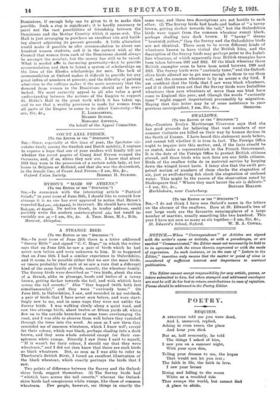A STRANGE BIRD.
[To THE EDITOR OP THE " SPECTATOR."1
Snt,—In your issue of June 25th there is a letter addressed "Surrey Hills" and signed "C. C. Hope," in which the writer says that on June 12th he saw a pair of birds which he had never seen before and were unknown to him. It so happened that on June 15th I had a similar experience in Oxfordshire, and it seems to be possible either that we saw the same birds, or (more probably) that each of us saw a rare (but a different) kind of the same family of birds, namely, the wheatear
The Surrey birds were described as "two birds, about the size of. a thrush, alike in plumage, heads and bodies of a tawny
brown, getting darker towards the tail, and with whitish bars across the tail coverts." Also "they hopped (with both feet simultaneously)," and they were "curiously tame." On June 15th, in Oxfordshire, I saw, and recorded in my notebook,
a pair a birds that I have never seen before, and were start- lingly new to me, and in some ways they were not unlike the
Surrey birds. I was walking slowly along a quiet road, and saw two strange birds, about twelve or fifteen yards off, whic.ii flew on to the outside branches of some trees overhanging the road, and I was able to observe them well before they vanished
through the trees into the wood. As soon as I saw them they reminded me of common wheatears, which I know wel', except
for their colour, which was black, perhaps shading into a dark brown, and they were whole coloured except for their con- spicuous white rumps. Directly I saw them I said to myself, "If it wasn't for their colour, I should say that they were wheatears," and I did not then know that there are such birds as black wheatears. But, as soon as I was able to refer to
Thorburn's British Birds, I found an excellent illustration of the black wheatear, which exactly portrays the birds that I saw.
Two points of difference between the Surrey and the Oxford- shire birds suggest themselves. (1) The Surrey birds had "whitish bars across the tail coverts," whereas the Oxford- shire birds had conspicuous white rumps, like those of common wheatears. Few people, however, see things in exactly the
same way, and these two descriptions are not hostile to each other. (2) The Surrey birds had heads and bodies of "a tawny brown, getting darker towards the tail," but the Oxfordshire birds were (apart from the common wheatear rump) black, perhaps shading into dark brown. If " tawny " Means "brownish yellow," then -the Surrey and the Oxfordshire birds are not identical. There seem to be seven -different kinds of wheatears known to have visited the British Isles, and the description of the Surrey birds may perhaps point to the Isabel- line wheatear, of which apparently four British examples have been taken between 1887 and 1912. Of the black wheatear three British examples seem to have been noted between 1909 and 1913. The Surrey birds were "curiously tame," and the Oxford- shire birds allowed me to get near enough to them to see them well, and the common wheatear is by no means a shy bird. I am confident that the birds that I saw were black wheatears, and if it should turn out that the Surrey birds were Isabelline wheatears then rare wheatears of more than one kind have come to England this year, and (though the words "curiously tame" might suggest importation) presumably by migration. Hoping that this letter may be of some assistance to your
previous correspondent, I am, Sir, &c., Osszavsa.










































 Previous page
Previous page